Free Lean
eBook
Pull Scheduling
Systems Overview
This eBook
provides all the Pull
Scheduling System basics,
including:
-
A summary of Lean
Manufacturing and Theory
of Constraints (TOC)
concepts
-
The logic behind Pull
Scheduling &
Production Planning
systems
-
Advantages and benefits
versus traditional
scheduling methods
-
Types of Pull
Scheduling Systems -
Includes KanBan, WIP Cap,
and DBR
-
How to get started
I've included simple
examples and diagrams so
that anyone can understand the
concepts presented.
To
get this free eBook, simply
add to your cart and complete
the free checkout process. The
eBook will then be emailed
directly to you.
$0.00 Pull Scheduling Systems Overview
The following is a preview
from the eBook:
I. The Case
for Pull Systems
This Chapter
will review Pull System
fundamentals and the benefits
of applying Pull Systems in
your business.
Let’s Get
Started
My first
exposure to Pull Systems was
in the mid 1980’s when I was
working for a subway car
re-manufacturer. In
re-manufacturing, you take
used products and rework and
upgrade them so they are like
new (or better). In the subway
car industry, the cars are
still in revenue service when
the Transit Authority
contracts to have them
re-manufactured. In order to
get them worked on, they have
to remove them from revenue
service, which they dislike
doing (for obvious reasons).
When they do remove them from
service, they want them back
in the shortest lead-time
possible.
Most
re-manufacture contracts in
the subway car industry have
requirements for these three
items:
Work in
Progress (WIP) – The
number of subway cars the
Transit Authority will
allow the re-manufacturing
company to have out of
revenue service at any
given time.
Lead-Time
(LT) – The amount of time
from when the subway car
is released from service
until it is returned to
service.
Rate – The
number of subway cars
delivered to the Transit
Authority per unit of
time.
During this
time, I was responsible for
both the scheduling of the
re-manufacturing process, and
the monitoring and analysis of
costs related to this process.
After a while, I realized that
there was a relationship
between these three variables:
Lead-Time =
WIP / Rate
Later on in my
career, I learned that someone
named “Little” had discovered
this formula before I had and
named it “Little’s Law”. This
simple little formula is very
powerful and is one of the
keys to pull systems.
Let’s look at a
couple of examples. If my WIP
was capped at 10 by contract,
and I was able to produce 2
units per week, what would my
lead-time be?
LT =
WIP / Rate = (10 units) / (2
units per week) = 5 weeks
If my WIP was
capped at 20 units, and I was
required to maintain a
lead-time of 4 weeks, what
would my rate have to be?
First
transform the formula LT =
WIP/Rate to Rate = WIP / LT
Rate =
WIP / LT = (20 units) / (4
weeks) = 5 units per week
Later on, when
I was exposed more formally to
pull systems, I realized that
our re-manufacturing customers
had forced a Pull System on
us. The general definition of
a Pull System is:
Pull System
– A scheduling system
where inventory is limited
in some way
Note –
Inventory can be raw
materials, WIP, finished
goods, etc.
Most businesses
do not put hard limits on
their inventories. Without a
limit, the amount and location
of inventory at any given time
is fairly random and will tend
to grow as time goes on. This
is considered a Push System,
which we will define as:
Push System
– A scheduling system
where inventory is not
formally limited
How did we
get to Push Systems?
Since we were
young, we have been taught
some basic work concepts such
as:
- Work hard
- Go fast
- Get ahead
The measures
and incentives we often use in
business support these
concepts. Typically, workers
and departments will have
measures and incentives for
units per day, units per
person, schedule attainment,
etc.
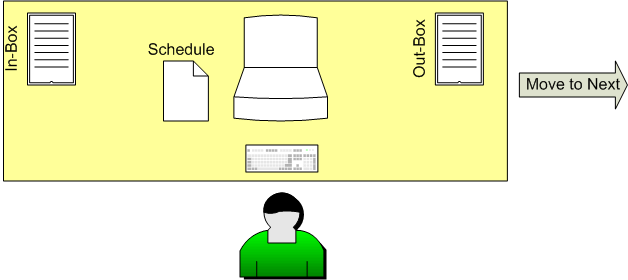
Figure 1
Let’s look at a
typical business scenario. A
worker works at a desk with a
computer on it. The worker is
given a schedule of what work
should be done when. Jobs
arrive at the desk and go into
an “In-Box”. The worker
reviews the schedule, takes
the next scheduled Job from
the In-Box, processes it using
the computer, and puts it in
the “Out-Box” when completed.
Periodically, the worker will
get up and move any Jobs
currently in the Out-Box to
the In-Box of the next step in
the process.
Each week, the
worker’s supervisor reviews
the number of Jobs completed
and whether the Jobs were
completed per the schedule. If
targets were not met, the
supervisor follows up with the
worker to take corrective
action.
Based on the
measurements in place, and the
worker’s focus on “Work Hard,
Go Fast, Get Ahead”, the
worker tries to stay busy. As
soon as a job goes to the
Out-Box, the next job on the
schedule is gathered from the
In-Box and started. If the
next job is not available, but
a later job is, the worker
starts that job instead.
What’s wrong
with Push?
There
are two assumptions we often
make when managing
businesses:
- Our business
processes are independent. A
change in one process will
rarely affect our other
processes in any adverse
way.
- Our business
processes are additive. To
see how well the business is
working, see how well each
of the processes is working
and essentially add them up.
To improve performance and
profitability, get each
process to be as efficient
as possible. An improvement
to one process will improve
the bottom line of the
company.
Based on these
assumptions, we manage our
business in a certain way. We
try to optimize each
department, area, and
individual process. Doing this
will maximize performance and
profitability. We often
schedule each process
separately – if they all
follow the schedule, the
overall schedule will be met.
We give each process
performance measurements so we
can tell if they are being
“efficient”.
Here is the
problem – These assumptions
are wrong! The following two
principles replace the flawed
assumptions:
- Our
business processes are
dependent. A change
in one process will tend
to affect some or all of
the other processes in
some way.
- Our
business processes are
not additive. An
improvement to one process
will usually not affect
the overall performance
and profitability of a
business in a positive
way. In fact, based on the
1st principle,
what is perceived to be an
improvement in one area
will actually reduce the
overall performance of the
system.
Let’s look at
an example of this.
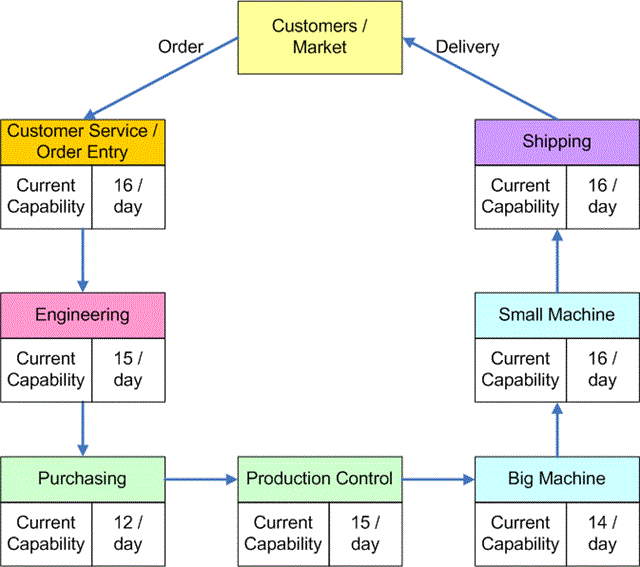
Figure 2
The diagram in
Figure 2 shows a “Business
Circle”. Every business has a
series of processes that
ultimately link together to
form a circle. The names and
capabilities of each box will
be different for each
business, but the general
concept will always be the
same.
Let’s say that
the “Engineering” box
represents the worker in the
Push System we described
previously. If the worker is
meeting the 15 per day goal
and is following the schedule
exactly, how many Jobs will
the business ship per day? The
answer is 12 per day. In this
circle, we can only go as fast
as our slowest process, which
is currently Purchasing at 12
per day.
Where are the
other 3 per day going? They
are stacking up in front of
Purchasing. What is happening
to out lead-time?
LT =
WIP / Rate, WIP is growing and
Rate is staying the same.
Therefore, LT is growing!
Is a growing
lead-time a bad thing?
Absolutely!
Every Lean
Manufacturing presentation
from the MEP Network has the
following quote from Henry
Ford:
“One
of the most noteworthy
accomplishments in keeping the
price of Ford products low is
the gradual shortening of the
production cycle. The longer
an article is in the process
of manufacture and the more it
is moved about, the greater is
its ultimate cost.”
Essentially
what Henry Ford is saying is
that the longer the lead-time,
the greater the cost, which
provides the following
formula:
Lead-Time =
Cost
This formula is
the essence of Lean
Manufacturing, which is
focused on the elimination of
non-value added activities.
Typically, 95%+ of a products
lead-time is non-value-added
time. Therefore, if we focus
on lead-time reduction, we
will inherently reduce
non-value-added-time and
become “Leaner”.
Lets go back to
our Engineer. At the end of
the year, his supervisor was
real happy because he met his
output and scheduling targets.
He received a big raise, and
then was challenged to improve
by getting his daily output up
from 15 Jobs per day to 17
Jobs per day. His supervisor
said this was necessary
because all the supervisors
had been tasked by the Big
Boss to improve efficiency
this year.
After much
analysis, hard work, and
overtime, the Engineer
implemented several changes to
his computer programs that
enabled him to get his daily
output up to 17 per day. At
the same time, the other
departments didn’t have quite
as much success. In fact,
Purchasing was still stuck at
12 per day.
What affect did
the improvement in Engineering
have on the overall business?
LT =
WIP / Rate, WIP is growing and
Rate is staying the same.
Therefore, LT is growing!
LT =
Cost, LT is growing.
Therefore, Cost is growing!
Wait a minute,
what is going on here.
Engineering improved, but
costs went up! Why is this?
Lets go back to
the two principles. Our
processes are not independent,
as a change in Engineering did
affect the other processes in
our system. Also, our
processes are not additive, so
an improvement in Engineering
did not improve our bottom
line.
So what are the
implications of these
principles?
- We must
manage the entire system to
optimize the business.
- Typically,
one process will limit the
effectiveness of the system.
This is considered the
system constraint. We can
make improvements to the
overall system by improving
the Constraint. All others
processes must be
subordinated to the
constraint.
- We can
improve lead-time and Costs
by reducing WIP, as long as
we don’t ever starve the
Constraint for work.
Instead of
making more stuff that wasn’t
going anywhere, wouldn’t we
have been better off if the
Engineer only made what
Purchasing needed and then
used the spare time to help
Purchasing process orders?
Why does
reducing lead-time reduce
costs?
This is not the
way we typically look at
costs. In fact, the Cost
Accounting systems that 95% of
businesses use today do not
reflect this at all. These
systems, which were developed
in the early 1900’s when
operations were much different
than they are today, allocate
overhead based on labor and /
or materials. In Traditional
Cost Accounting, the only time
a Job accumulates cost is
during the actual step where
labor or materials are applied
to the product. This is
typically a value added step
and accounts for less than 5%
of the total lead-time. The
time between steps, where the
product is not having value
added to it, are considered
“free” by this Cost Accounting
system.
A graph of
cumulative product cost
throughout the lead-time to
complete the Business Circle
looks like this:
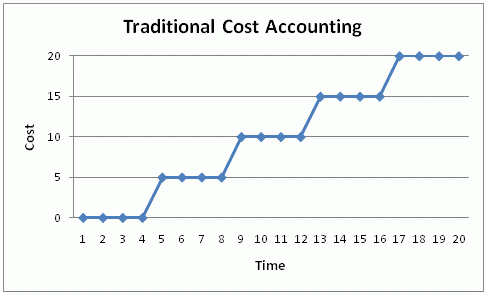
Figure 3
However,
applying Henry Ford’s
philosophy of LT=Cost yields a
graph that looks like this:
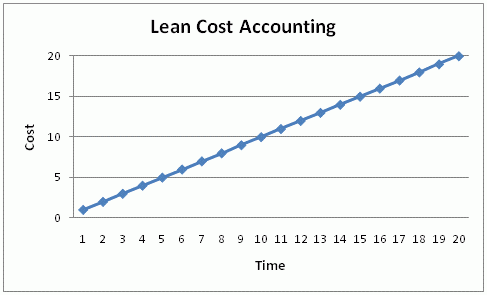
Figure 4
Goldratt, who
created the Theory of
Constraints, once said:
“Tell
me how you measure me and I’ll
tell you how I’ll behave.”
If our
measurements drive our
behaviors, what type of
behavior is traditional cost
accounting driving? Instead of
focusing on lead-time,
traditional cost accounting
causes us to focus on the
small portion of time when
labor and material are applied
to the product.
The benefits of
reducing processing lead-time
are too numerous to list here.
Insyte Consulting, which is
the MEP Center in Buffalo, NY,
has a spreadsheet on their
website that documents 31
benefits of reducing
lead-time. Click here for a
link to this spreadsheet.
These benefits generally roll
up into 6 categories:
- Increased
sales
- Improved
quality
- Reduced
operating costs
- Increased
capacity and throughput
- Reduced
invested assets
- Increased
employee satisfaction
(morale)
Let’s use a
production work center at a
manufacturing company as an
example. The work center is
located half way through the
overall product routing. Say
the work center has 1 month of
WIP valued at $100,000 stacked
up in front of it.
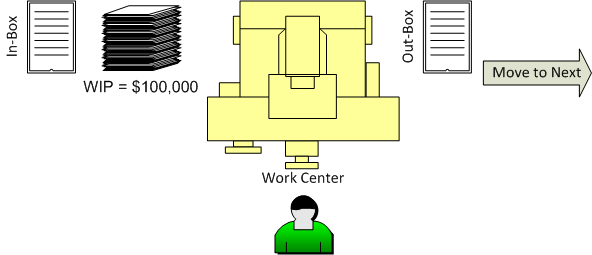
Figure 5
According to
the Traditional Cost
Accounting system, this WIP is
not costing the company
anything. In fact, it is
included as an asset on the
balance sheet. Also, if
aggregate WIP grows during any
particular year, it will
appear to make the company
more profitable on an accrual
accounting income statement.
According to
Lean Cost Accounting, which is
a more correct way of looking
at this, this WIP is costing
the company money. Why is
that? The following are a few
of the reasons why:
- Cost of
capital – A typical company
will have a line of credit
and / or wish to lease or
purchase equipment. If the
$100,000 was not sitting
here, the company could
reduce it’s credit line by
that amount or invest in new
equipment or other assets.
- Cost of space
– That month’s worth of WIP
will take up space.
Manufacturing space costs
money. We also have costs
associated with heating,
cooling, and lighting that
space.
- Cost of
handling – During the month
that these products sit
waiting to be worked on,
they will usually get moved,
stocked, re-sorted, split,
combined, etc, numerous
times. The cost to do this
includes not only the labor,
but the resulting damage to
the products and the
potential for injuries.
- Cost of
quality – If we discover
that something is wrong with
a product in this WIP
inventory, how many might be
bad? Potentially all of
them! These will have to be
re-worked or scrapped and
re-made. Since the previous
manufacturing steps occurred
a month or more ago, our
chances of identifying the
root cause of the problem
and taking effective
corrective action are low.
- Lost
throughput – The presence of
random WIP all over the
place effectively masks
where our slowest operation
is. Without knowing where
this is and focusing our
efforts on it, we loose
overall throughput in the
system
- Lost sales
opportunities – Many
customer orders are awarded
based on supplier lead-time.
In general, customers are
poor planners. Since
LT=WIP/Rate, this WIP is
adding to lead-time, which
is taking away this market
opportunity.
- Reduced
on-time delivery – The
longer your processing
lead-time, the harder it is
to deliver on-time. Also,
the more likely it is that
customers will change
designs, quantities, due
dates, etc.
A full
introduction to Lean or TOC
cost accounting is beyond the
scope of this document.
However, a good general rule
when making business decisions
is to focus on the decisions
effect on Cash Position and
Cash Flow versus accrual
accounting profit. Decisions
that improve overall Cash
Position and / or Cash Flow
will ultimately improve your
business. Also use this method
when evaluating relative
success after implementation
of any improvement idea.
How does
all of this relate to Pull
Systems?
There are many
things that contribute to a
long processing lead-time.
However, the 80/20 rule would
suggest that a few policies /
systems contribute the most to
our overall lead-time. In my
experience, the low hanging
fruit that has the biggest
impact on our lead-time is:
- Scheduling
systems
- Batch
sizing
Pull systems
address both scheduling and
batching. The application of a
few relatively simple pull
techniques can quickly reduce
processing lead-times by 50%
or more.
Many Lean
practitioners consider Pull
System to be advanced
techniques to be applied late
(if ever) in an overall Lean
implementation. TOC
practitioners consider Pull
Systems to be a foundational
step that is usually applied
first in any improvement
initiative. I strongly agree
with the TOC approach. If
lead-time is the main focus,
and if Pull Systems are a
method of addressing the major
contributors to long
lead-time, then lead-time
improvement initiatives should
start with the application of
Pull Systems.
You will find
that once you have implemented
Pull Systems and your
lead-times are reduced, the
other critical issues in your
system will become painfully
obvious and easier to address.
You will also have a tool to
focus your limited improvement
resources on initiatives that
will really make an impact and
not waste them on initiatives
with no (or negative) return
on investment.
To get
the entire eBook, simply add
to your cart and complete the
free checkout process. The
eBook will then be emailed
directly to you.
$0.00 Pull Scheduling
Systems Overview
This
eBook is now available in Russian,
Simplified
Chinese, and Complex
Chinese.